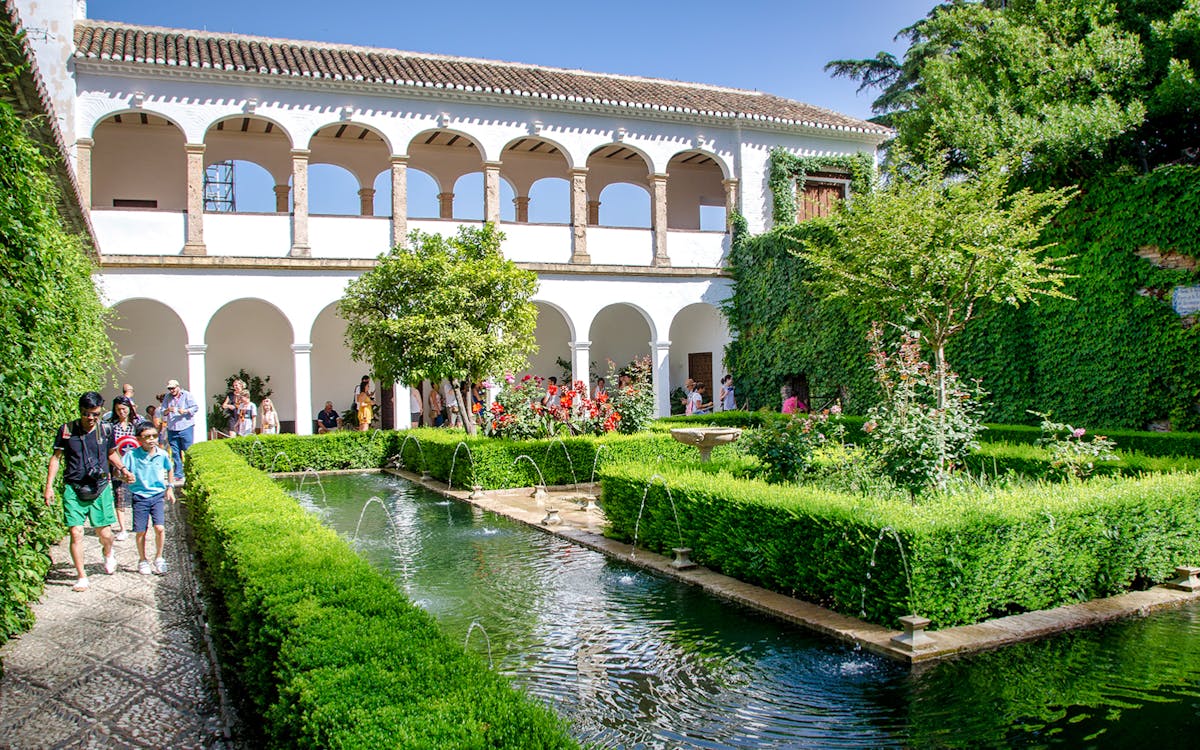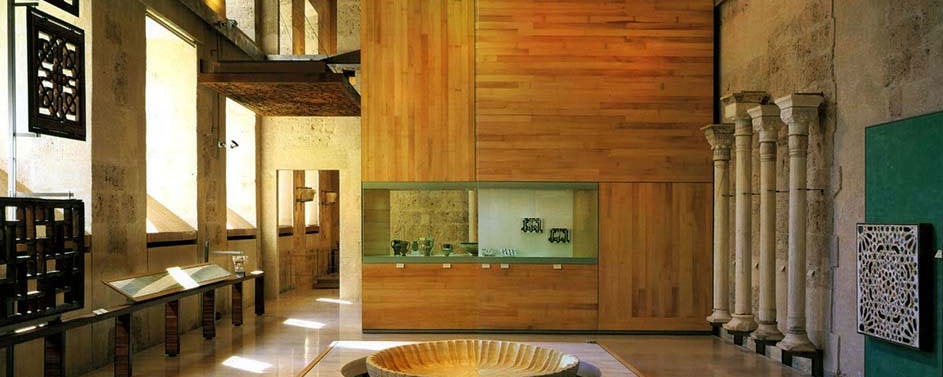The Alhambra is a marvel of intricate stone, plaster, and wood, and the world's last and grandest Moorish fortress. It is one of Spain's, if not the world's, most popular tourist destinations. It's also the most amazing must-see attraction in Granada, exhibiting the luxury of the Moorish imagination. In 1984, the Alhambra was designated as a UNESCO World Heritage Site, a testament to the beauty and enchantment of the iconic landmark.
The Alhambra never ceases to amaze visitors, from its delicate Arabic carvings to its bright, vivid tiles to its breathtaking views of the Albayzn. It's no surprise that this magnificent palace attracts over 6,000 tourists per day. Anyone visiting Granada should make a point of visiting the Alhambra, but there’s a lot more to the fortress than its spellbinding exteriors. Here’s a detailed look at what’s inside Alhambra and why it’s worth your time.
Inside Alhambra: Practical Information
Opening Hours
Getting There
April 1 to October 14
- Day Visit: Monday to Sunday: 8:30am to 8pm
- Evening Visit: Tuesday to Saturday: 10pm to 11:30pm
October 15 to March 31
- Day Visit : Monday to Sunday: 8:30am to 6pm
- Evening Visit : Friday & Saturday: 10pm to 11:30pm
- Bus: Take bus number C3 from the Isabella and Columbus statue and get off in front of the Alhambra entrance for just €1.2.
- Taxi: For €6, you can take a taxi from anywhere in central Granada and get dropped at the entrance of your choice.
- Car: If you're driving from Granada, the trip should take approximately 15 minutes, and there's plenty of parking on the plateau.
Before You Go Inside
In 889 A.D., the Alhambra was founded as a modest stronghold on the foundations of ancient Roman ruins. The Arabic word "Alhambra" translates to "red castle," due to the red clay used in its construction. When Mohammad I, the first Nasrid sultan, came to power in 1232, he erected a royal mansion. Throughout the 13th and 14th centuries, successive kings built several expansions and alterations.
Following the city's Christian conquest in 1492, the conquerors began to remodel the Alhambra. The work done in the 1930s by Leopoldo Torres Balbás was particularly renowned. The young architect re-excavated filled-in pools, replaced missing tiles, completed inscriptions, and built a ceiling in the still-unfinished palace of Charles V.

Why You Must Go Inside The Alhambra
Glimpses of a Glorious Past
The Alhambra is an important monument because it demonstrates that Arabs formerly governed this region, and its architectural style is a vestige of that era. The best way to learn about the history of this legendary landmark is to go with a guide who can show you around the most hidden areas of this massive architectural marvel. You will travel through time while listening to the guide's anecdotes, visualizing the Sultan's luxurious existence with his courtiers inside the palace apartments. If you're not a fan of guided tours, you can also explore the fortress on your own but you might miss out on some must-see parts.
The Palace Puzzle
The Alhambra is a massive architectural complex with palaces that should not be overlooked. The Nasrid Palace and the Palace of Charles V are two of them, each from a different historical time. The first, Nasrid Palace was the oldest and the center of administrative responsibilities, whilst the Palace of Charles V was erected as Emperor Charles' palace. Because it is positioned next to the Nasrid Palace, the Palace of Charles V stands out sharply against the surrounding Islamic architecture. You can see two entirely distinct but equally stunning architectural styles in these two palaces.
Andalusian Art
The Alhambra does not have any paintings or photographs on exhibit. Why? Because the Alhambra is a work of art itself, with inlays and colors covering every centimeter of the structure's walls, making a thick weave of arabesques carved piece by piece with miniature molds. These decorative patterns have a very specific meaning: they are created using aesthetic concepts of recurrence and harmony of individual self-replicating units that depict God's omnipresence and wholeness. Explore the insides of the Alhambra to better appreciate this relatively unknown art form.
Your Alhambra Tickets
There are many different types of Alhambra tickets available for purchase online. Here are our personal recommendations:
Skip The Line Access
Small Group Tours
Choosing The Right Alhambra Entrance
Pavilion Main Entrance- This entry, on the extreme east side of the Alhambra, is for guests who do not have a ticket or who need to pick up their QR code-based tickets. Proceed to the Access Pavilion ticket office, which is a short distance from the Pavilion Main gate. The Alcazaba, Nasrid Palaces, and Generalife are all within walking distance of the Pavilion Main Entrance. If you have a ticket already but one without a QR code, you’ll have to go through this entrance.
Those arriving by automobile will find a large parking lot near the Pavilion's main entrance.
Gate of Justice Entrance- Visitors with a QR-barcoded ticket can enter through the Gate of Justice. This gate does not have a ticket office and when compared to the Pavilion Main Entrance, the lines at the Gate of Justice are usually shorter. Closest to this gateway are the Alcazaba, Charles V Palace, and Nasrid Palaces.
If you’re around the old town, this entrance will be closer for you. You can use the bus to get to this entrance because there is no parking close to it.
Route Guide Inside Alhambra
There are 3 primary places of interest during your visit to the Alhambra. While Alcazaba and Generalife can be visited anytime, your time slot for visiting the Nasrid Palace will be mentioned on your ticket. Plan the order of your visit to these places accordingly.
Alcazaba

The Alcazaba military fortress, the oldest section of the Alhambra, was ideal for surveillance because of its advantageous location high on a hill overlooking the city. Some historians believe that sections of the edifice existed before the arrival of the Moors in the city. It was utilized as a dwelling quarter by the first monarchs while the Nasrid palaces were being built, and afterward, it was repurposed into a fortress.
For incomparable views of Granada and the Sierra Nevada mountains beyond, climb to the top of the historic watchtower (Torre de la Vela). The ruins of old Moorish dwellings and even a dungeon can be located behind the towers in the old Plaza de Armas!
Nasrid Palaces

The Nasrid Palaces were the main palace of the Moorish kings of Granada and are perhaps the most well-known component of the Alhambra. This section alone has several different elements. During the Moorish period in Granada, the many sultans that occupied the Alhambra began to add numerous royal houses to the palaces, completing them into the distinctive complex we know today.
Generalife

The Generalife, located outside of the Palacios Nazari, contains some of the most exquisite labyrinthine gardens in the world. On a bright day, you can easily spend hours strolling through the many tranquil gardens, which are filled with fountains, flowers, and beautiful scenery. You'll be able to view the vibrant gardens in full bloom if you visit in the spring or summer.
Palace of Charles V:

The Palace of Carlos V, which is much newer than the rest of the complex, stands out among the Moorish architecture because of its more modern, Renaissance design. The regal structure is surrounded by a circular courtyard with towering pillars that support two large levels. The one-of-a-kind design represents the marriage of heaven and earth, a key topic for Renaissance architects.
Museum of Fine Arts

The Palace's top floor houses the Fine Arts Museum, which boasts a collection that includes sculptures and paintings by Grenadian artists from the fourteenth to the twentieth centuries. Works of art of Romanticism, Baroque, Neoclassicism, and grenadine painting from the 19th and 20th centuries, including Manuel Angeles Ortiz, are also among the museum's most important.
Museum of the Alhambra

The Alhambra Museum is located on the ground level of the Palace of Charles V on the south side. It is divided into seven halls, the first of which houses thematic exhibitions and the rest of which are arranged chronologically. The Provincial Commission of Monuments established the museum in 1870 to protect the numerous archaeological evidence gathered by the commission.
Alhambra: Insider Tips
- In several areas of the Alhambra Palace, selfie sticks, camera lights, bulky backpacks, and tripods are prohibited.
- Enter the fortress through the Gate of Justice if you have pre-purchased Alhambra Tickets online. It is closer to the Alcazaba and Nasrid Palaces, with shorter lines than the main gate.
- For visitors with limited mobility, wheelchairs can be rented from the Entrance Pavilion. Follow the disabled route sign for a comfortable visit
- There are free lockers available at the Alhambra. You can check one medium-sized bag per person at the locker room near the Carlos V Palace.
- In any season, Saturdays and public holidays are the busiest days. In addition, if a public holiday falls on a Tuesday or Thursday, the Spanish perform a Puente (bridge), taking the Monday or Friday off as well, providing for a long weekend. Avoid visiting on any of these days for fewer crowds.
Ready to head to Alhambra Granada?
Purchase discounted Alhambra tickets via Headout today!
Explore The Rest of Granada
Fancy heading out to some other must-visit Granada attractions? Take inspiration from our list of the best things to do in Granada here. Use our comprehensive Granada Travel Guide to explore the rest of Granada in a hassle-free fashion with all the need-to-know information in hand.
Inside Alhambra: FAQs
Where can I get the finest Alhambra views?
Where can I get the finest Alhambra views?
How much time is required to visit the Alhambra?
Is bringing outside food allowed inside the Alhambra?
Is bringing outside food allowed inside the Alhambra?
Where can I find restrooms in the Alhambra?
Where can I find restrooms in the Alhambra?
Is photography allowed inside the Alhambra?
Is photography allowed inside the Alhambra?


